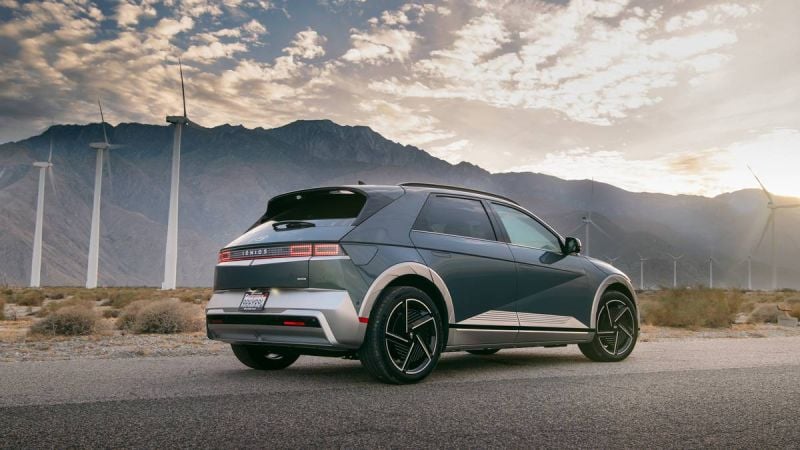Once upon a time, a dead 12-volt battery was the calling card of forgotten ‘87 Cutlasses in apartment complex parking lots and third-hand Civics rotting behind barns. But in the electrified utopia promised to us by the likes of Hyundai, Rivian, and General Motors, it turns out that same little lead-acid gremlin is still haunting the garage like it’s 1982. This time, it’s just wired into a $50,000 car. The 12-volt battery drain is quietly becoming the Achilles’ heel of modern EVs, and worse, not a single manufacturer seems to know how to fix it.
Roadside Rescues For EVs
EVs are fast, efficient, and smoother than a politician’s apology. But buried in their digital veins is a dirty little secret… most of them still rely on a humble 12-volt auxiliary battery to keep systems like locks, lights, and telematics alive.

When it goes dead, you don’t just lose headlights, you lose everything. And unlike an internal combustion car, you can’t just pop the clutch or boost it with your buddy’s Tacoma. You’re toast until roadside rescue shows up with jumper cables and pity. For reasons unknown, the 12V battery drain issue is something no manufacturer can solve, including Hyundai, GM, and Rivian.
What The Hyundai Ioniq 5 Offers
- The 2025 Hyundai Ioniq 5 offers a range of powertrains, including a high-performance Ioniq 5 N variant with 650 horsepower, capable of accelerating from 0 to 62 mph in just 3.4 seconds.
- Equipped with an 800V charging system, the Ioniq 5 can charge from 10% to 80% in approximately 18 minutes using a 350kW charger. The Long Range RWD model offers an EPA-estimated range of over 310 miles.
- The Ioniq 5 features a spacious interior with a flat floor, allowing for flexible seating arrangements. It includes advanced safety features like a 360-degree Surround View Monitor and has achieved a 5-star Euro NCAP safety rating.
This is not a hypothetical nuisance. It’s a widespread, borderline epidemic that manufacturers have yet to publicly own up to in any meaningful way. Online forums like r/Ioniq5 and r/Rivian are littered with tales of EVs going flat overnight, parked innocently in garages, only to become $50,000 paperweights.

That’s where a methodical, data-hungry Redditor named u/PrivatePilot9 enters the chat. Frustrated by the guesswork and dealer shrugs, he decided to monitor his 2022 Ioniq 5’s 12V battery over the course of a week, post-ICCU firmware update, and what he found was both enlightening and baffling.
“I am an active r/homeassistant user, and one of the data points that the amazing Bluelink integration provides is the 12V battery status. So, I started logging it, updated about every 20–60 minutes. It's also important to keep in mind that some of this data disproves (or at least partially discounts) the fear that many have that polling the car via Bluelink too often is automatically going to flatten the 12v…”
Bluelink, it turns out, isn’t the villain. Even under constant monitoring, 2 to 3 data pulls per hour, the battery held fairly steady… as long as the car was plugged in.
An Eyebrow-Raising Moment
Once the Ioniq was left unplugged, things got unpredictable. The voltage began to fall, not drastically, but enough to raise eyebrows. And while the traction battery eventually kicked in to resuscitate the 12V system, it did so with all the urgency of a housecat deciding whether to acknowledge your existence.
“It then went up 2% overnight (despite not being plugged in)… so it’s apparent that the car decided to maintain the 12V from the traction battery at that point,”
Not exactly confidence-inspiring.
There’s something profoundly absurd about a state-of-the-art electric crossover playing voltage roulette with its brainstem. According to u/PrivatePilot9,
“So, despite being polled extremely frequently via Bluelink, the battery never goes below 85% at which point the ICCU seems to happily just maintain it there with the traction battery…”
That’s good news. But it also underscores how tenuous this balancing act really is. A missed software cue or logic delay, and suddenly you’re staring at a blank dashboard, wondering how you’re going to pick up the kids from school.
The Most Troubling Part Of It All
Perhaps most troubling is that this problem is not tied to old or abused batteries. In fact, it's quite the opposite.
“The 12V AGM battery in my 2011 Volt lasted 12 years and was still serviceable… I’m not sure why the Ioniq 5 is so hard on batteries in comparison.”
That’s the mystery. Despite less physical load and more intelligent energy systems, EVs seem to chew through 12V units faster than an ‘05 Taurus. Is it the ICCU logic? Poor charge cycling design?

Inadequate prioritization of standby loads? Nobody, not even the automakers, seems to know for sure.
What Causes The Battery Drain?
- Devices like dash cams, GPS trackers, or OBD-II dongles can continue to draw power from the 12V battery even when the vehicle is turned off. Over time, this continuous drain can deplete the battery, especially if the vehicle isn't driven regularly.
- Some EVs rely on a DC-DC converter to maintain the 12V battery's charge using the main traction battery. If this system fails, due to software glitches or hardware issues like a faulty Integrated Charging Control Unit, the 12V battery may not receive adequate charging, leading to depletion.
- Leaving an EV parked and unplugged for extended periods can result in the 12V battery discharging. Even when not in use, certain systems may continue to draw power, and without regular charging, the battery can become depleted.
And this isn’t just a Hyundai problem. Across brands, from Rivian to GM to Ford, owners are encountering eerily similar symptoms. As one Ioniq 5 owner noted, their 12V battery completely failed at just two years of age, a lifespan so short it wouldn’t even raise a child to toddlerhood. The issue is so prevalent and so perplexing that forum posts have become de facto technical manuals.
“It’s very unusual in any EV application for the 12V battery to not last many, many years. Clearly, there is (or hopefully, was) something very wrong with how the ICCU was behaving pre-update…”
The real kicker? These aren't exotic, temperamental machines. These are mass-market daily drivers. Hyundai Ioniq 5s, Ford F-150 Lightnings, Chevy Bolts. We’re not talking about the Pagani Huayra. These are practical, theoretically reliable appliances meant to usher in the next era of mobility, and they’re being tripped up by a component designed before Elvis got drafted.
Maybe in the not-so-distant future, we’ll all have a laugh about it, how the first generation of EVs could slingshot you into the future, but might leave you stranded in your driveway on a rainy Tuesday because the car forgot to feed its 12V battery overnight, it makes you wonder if other solutions are out there.
Ever been left stranded because your EV’s 12V battery just randomly gave out?
Did it make you miss an important appointment, or maybe even a date?
Drop your story in the comments below. We want to hear what happened.
Image Sources: Hyundai Newsroom
Noah Washington is an automotive journalist based in Atlanta, Georgia. He enjoys covering the latest news in the automotive industry and conducting reviews on the latest cars. He has been in the automotive industry since 15 years old and has been featured in prominent automotive news sites. You can reach him on X and LinkedIn for tips and to follow his automotive coverage.












Comments
What happens if the 12v…
Permalink
What happens if the 12v battery is disconnected? Would that prevent the slow drain of its power?
2 important thoughts here: 1…
Permalink
2 important thoughts here:
1--Low voltage from the 12v battery makes evs and hybrids go haywire. When the battery in my ELR became weak, it caused the car not to unlock properly, and caused MANY weird driver information center messages. so a word to the wise, if you think something is seriously wrong with your vehicle, charge the battery and clear the codes. Test the battery and replace if needed.
2- Battery problems are not endemic to all models, or even all cars of a certain model. I owned a '17 Chevy Bolt, and sold it after 4 years and 39,000 miles. Original battery, never once went dead. I also own since new a 2016 Cadillac ELR (essentially a fancy Chevy Volt) and do know that after 30 days it stops maintaining the 12v battery, even if plugged in. I do not drive the ELR from November through March due to not wanting to perforate the undercarriage from the aggressive salt where I live and the low profile 20" tires being deadly on ice and snow. During that time it is plugged in and sits in a garage that while not heated is below my bedroom and significantly warmer than outside. The answer was to unplug it every few weeks and plug it in again after a few hours. The original battery lasted about 5 years, and the current battery is going on 5 years. ONE battery problem I DID have with the ELR is that it is supposed to tell you on the dash if the remote battery is weak. It did not, and never has. When it doesn't work from across the parking lot at the supermarket anymore, change that remote battery! The only vehicle I have had a 12v battery problem with is a 2009 Ford Fusion SEL AWD (purchased 12/08), which has spent weeks at the dealer under warranty to figure out why it will drain the battery to zero after a period of time left sitting, sometimes as little as a week, other times as much as 2 months. I finally gave up and keep it on a battery maintainer (I did install a battery monitor, but it has never provided any information that helped identify what is draining the battery or when it is occurring).
We left our 2024 Ioniq 5,…
Permalink
We left our 2024 Ioniq 5, which had been charged to 85%, unplugged while we were away for 2 weeks. It was dead when we tried to start it. Called the service center at the dealership and they told us to jump it and that we should leave it plugged in when we went away or on a trickle charge. Seems like way too much trouble, glad we didn’t bring that car to the airport. And glad we choose to lease the car rather than buy.
My Leaf's battery lasted…
Permalink
My Leaf's battery lasted about 4 years. My first Tesla's battery lasted the 3 years of the lease. But both rarely stayed unplugged more than 8 hours a day.
Tesla had this problem on…
Permalink
Tesla had this problem on their Model 3 in 2018. They allowed the 12V battery to drop too low before recharging. And unlike Lithium Ion batteries, Lead Acid batteries become bricks when they drop too low. Their solution was raise the minimum lead acid voltage before recharge so that it never gets near brick voltage. I’m at 5 years on the current 12V lead acid battery.
My new Kona Ev CAME with a…
Permalink
My new Kona Ev CAME with a flat 12v battery! Kept going flat so invested in a SMALL 12v battery and jump leads. When the car won't start, open the bonnet(hood), connect the jump leads and the car starts. Disconnect the jump leads immediately and away you go. Not ideal but it works since the car charges the main 12v battery as soon as it starts,
Yep, sitting here in Canada…
Permalink
Yep, sitting here in Canada with an Ioniq 6 we have had for two years. Been flawless until a month ago. Battery died over night. Boosted it, and drove fine. Then died again overnight. Took it to the dealer, who replaced the 12v, only to have it be dead the next morning. They have now had it for over a month, dealing with Hyundai Canada and trying different solutions.
So frustrating and disappointing.
Hi Noah, interesting article…
Permalink
Hi Noah, interesting article. Our Hyundai Kona, now nearly five years old, has been suffering from this issue on a regular basis. During its first two years while the 12V battery was still under warranty, the car went completely flat overnight several times and needed the services of a rescue organisation to get it going again. Unsurprisingly, being completely flattened several times damaged the battery and before the car's second anniversary, I tested the battery's capacity and found it to be less than half its nominal value. I gave my data to the servicing garage when its 2nd annual service was due and asked if they could replace the battery under warranty - they disputed my data and refused. Two months later the 12V battery failed completely and I had to buy a new one myself. I now put a small 12V charger on the car if we leave it for more than a week, but sometimes it will still go flat overnight even though the traction battery is nearly fully charged.
I have an Ionq 5, 2024 with…
Permalink
I have an Ionq 5, 2024 with 16,000 kms. My 12v battery died in middle of a busy intersection yesterday. I got a very unsatisfactory response from the Hyundai dealership when I was in serious trouble. I still don't have my car back and don't have a loaner. I live in Orillia, Ontario. Very frustrating. I never received a recall notice from Hyundai.
I just traded my 2021 Tesla…
Permalink
I just traded my 2021 Tesla Mid 3 for a 2025 Ioniq5 Ltd. For the four years we've had the M3, we never had the car not start on us. We did get notified to replace it soon, which we did, but that's it. I've had the I5 three months and twice it went completely dead on me. I keep it plugged into my L2 charger every night. My wife and I are retired so we don't drive every day, sometimes four or five days between drives. Any suggestions?
Pagination